NavSource Online: Submarine Photo Archive
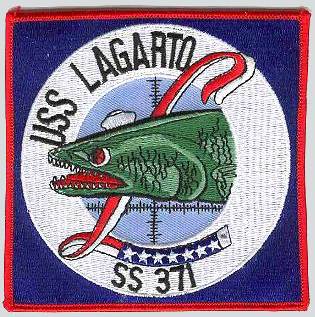
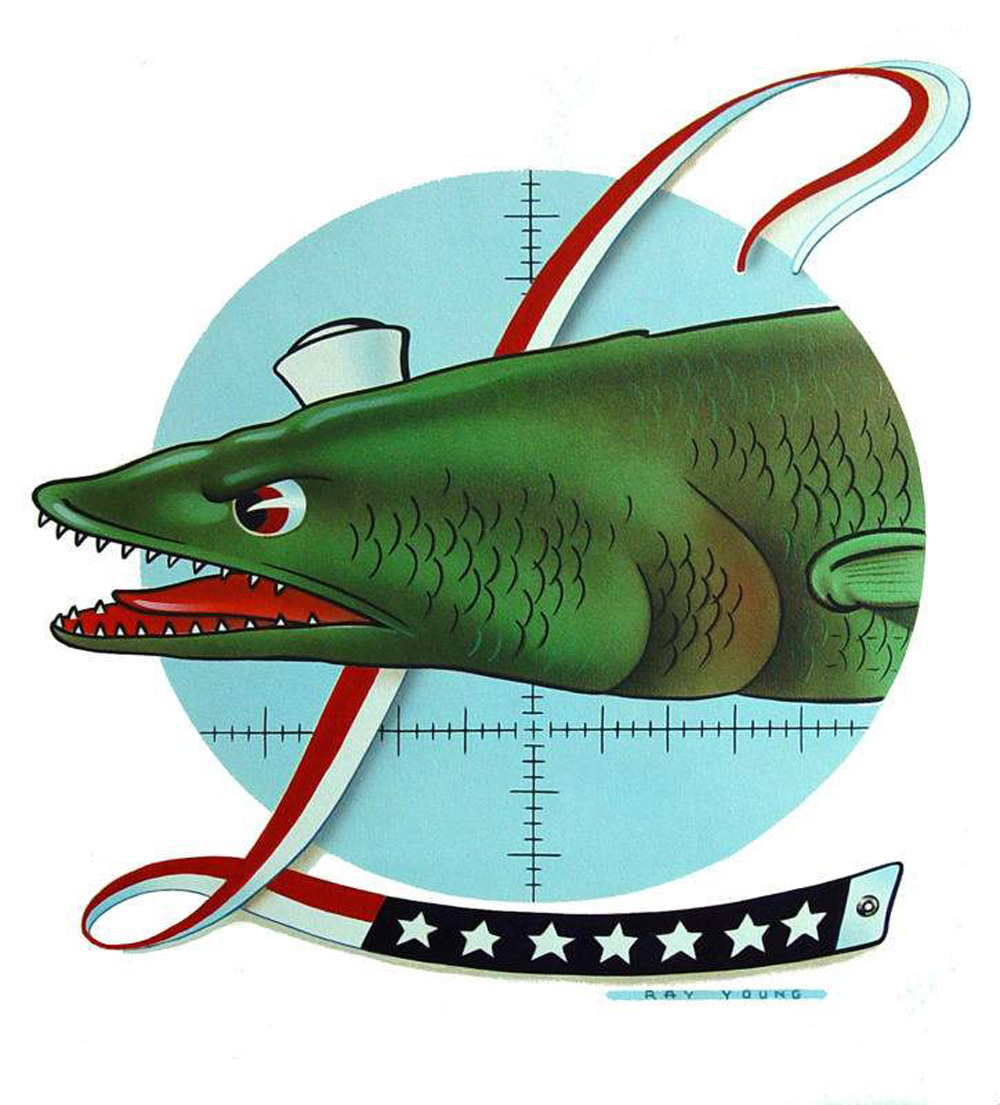
Patch on left contributed by Mike Smolinski, on right by Ray Young.
Lagarto (SS-371)

![]()
![]()
![]()
![]()
Balao Class Submarine: Laid down, 12 January 1944, at Manitowoc Shipbuilding Co., Manitowoc, WI.; Launched, 28 May 1944; Commissioned USS Lagarto (SS-371), 14 October 1944; Sunk on 2nd patrol by Japanese netlayer Hatsutaka on 3 May 1945, in the Gulf of Siam, all hands lost. Struck from the Naval Register, 1 September 1945. Lagarto received one battle star for World War II service. As built to the specifications: Displacement, Surfaced: 1,526 t., Submerged: 2,424 t.; Length 311' 9"; Beam 27' 3"; Draft 15' 3"; Speed, Surfaced 20.25 kts, Submerged 8.75 kts; Cruising Range, 11,000 miles surfaced at 10kts; Submerged Endurance, 48 hours at 2kts; Operating Depth, 400 ft; Complement 6 Officers 54 Enlisted; Armament, ten 21" torpedo tubes, six forward, four aft, 24 torpedoes, one 5"/25 deck gun, one 40mm, one 20mm, two .50 cal. machine guns; Patrol Endurance 75 days; Propulsion, diesel-electric reduction gear with four General Motors main generator diesel engines, 5,400 hp, Fuel Capacity, 116,000 gals., four General Electric main motors with 2,740 hp, two 126-cell main storage batteries, two propellers.
| Click On Image For Full Size | Size | Image Description | Source | |
|---|---|---|---|---|
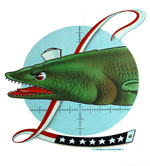 | 281k | Insignia of the Lagarto (SS-371) designed for the submarine by Ray Young, circa 1944. | Editors Note: There are over 200 images submitted on these pages covering the following submarines that were constructed at the Manitowoc Shipbuilding Co, Manitowoc, WI,: SS-265 through SS-274, and SS-361 through SS-380. None of them would have seen the light of day if it were not for the efforts of Curator, Asst. Director, Bill Thiesen of the Wisconsin Maritime Museum and Larry Bohn, who sent them to NavSource for publication. A special debt of gratitude is owed to these two men and the Wisconsin Maritime Museum, home of the Cobia (SS-245), for allowing these photographs to be seen by the lovers of naval history worldwide. Photo by Ray Young, courtesy of his son, William Young. |
|
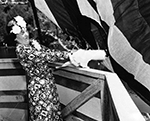 |
538k | Lagarto (SS-371) at launching. Shown: Emily Taft Douglas, christening. Congresswoman from Illinois and wife of Capt. Paul H. Douglas, USMCR, (later U.S. Senator from Illinois). Photograph is curved. |
USN photo # 80-G-409532 courtesy of National Museum of the U.S. Navy. Insert photo courtesy of Office of the Historian, U.S. House of Representatives via wikipedia.com. | |
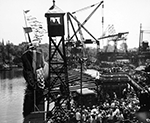 | 594k | Lagarto (SS-371) slides down the ways at Manitowoc Shipbuilding Co., Manitowoc, WI. 28 May 1944. | Photo # 80-G-40951 by Harry Berns, Official photographer of the Manitowoc Shipbuilding Co., Manitowoc, WI., courtesy of National Museum of the U.S. Navy. | |
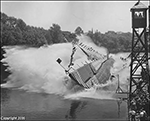 | 239k | Freed from her launching timbers, the Lagarto (SS-371) slides down the ways at Manitowoc Shipbuilding Co., Manitowoc, WI. 28 May 1944. "The boat had been built on the building ways, consisting of a set of wooden blocks in a horizontal line and parallel to the face of the sea wall. After the sections were placed on these blocks a cribbing, or supporting structure, was erected to support the sections in place and to prevent movement. As the date for the launch approached the workers constructed a second set of ways. These launchings ways were at right angles to the sea wall and extended inboard under the boat. They were massive fur timbers, 16" x 24", placed about 14" apart and supported by cribbing of a size and strength to support the weight of the boat during the launch. The launching was sloped down toward the seawall at an angle of 1 and 19/32" per horizontal foot. For the launch of a submarine, a total of 21 lauching ways were used. All except the forward and after three extended 12' past the sea wall, and were capable of tilting when the submarine went over the sea wall. This was to eliminate the possibility of damage to the vessel's structure and to the launchways at the moment when the boat pivoted at the dock's edge. The forward and after three ways were known as the fixed ways and extended only to the sea wall and did not tilt. They were firmly fixed in place to take the full horizontal thrust of the vessel just prior to launch. The trigger was held in place by means of a trigger line, an 8" manila line was set up with a block and tackle to a fixed point, a deadman or other fitting, inboard of the vessel. Sliding ways were placed on the launching ways and on these were built the lauching cradles. The cradles were built to confirm to the shape of the hull and were constructed so as to be as snug as possible to the hull. Between individual pieces of the cradles were inserted oak wedges, so positioned as to be readily accessible for driving by hand. The trigger lines were cut at the moment of launch by means of pneumatic rope cutters or guillotines containing a piston attached to a cutting knife and actuated by compressed air from a central master valve. They were so calibrated that air reached each cutter at precisely the same instant." | Photo by Harry Berns, Official photographer of the Manitowoc Shipbuilding Co., Manitowoc, WI. Photo courtesy of abcnews.com. Text from "Fresh Water Submarines, The Manitowoc Story, pg 43-44, by Rear Admiral William T. Nelson, U.S.N. (Ret.)" |
|
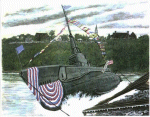 | 55k | Watercolor print by the artist Tom Denton of the side launching of a Manitowoc built boat. | Courtesy of Submarine Art | |
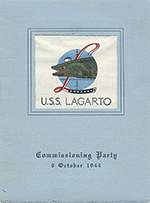 | 226k | Commissioning party invitation for the Lagarto (SS-371), on 9 October 1944. | Photos courtesy of Wisconsin Maritime Museum | |
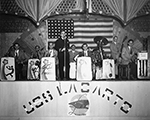 | 184k | The stage is set at Silver Lake Lodge near Manitowoc, Wisconsin during the commissioning party for the Lagarto (SS-371), on 9 October 1944. Members of the Dick Fricke Orchestra, which provided music for the event, are seated on stage with their instruments as a Navy officer in uniform stands at a microphone. | Photo courtesy of Wisconsin Maritime Museum | |
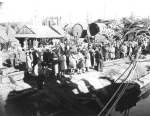 | 68k | Lagarto's (SS-371) conning tower shadow in the background casts onto the crowd at launching day at Manitowoc Shipbuilding Co., Manitowoc, WI. 28 May 1944. Note the sub parts in the far background. They are being scrapped out. The building program had been terminated and many parts had already been fabricated for the canceled subs Needlefish (SS-379) & Nerka (SS-380). | Photo by Harry Berns, Official photographer of the Manitowoc Shipbuilding Co., Manitowoc, WI. Submitted by Larry Bohn, courtesy of the Wisconsin Maritime Museum, home of the Cobia (SS-245) | |
 | 41k | Plank owners pose for this commissioning photo on the stern of the Lagarto (SS-371) in Manitowoc on 14 October 1944. | Courtesy of Karen Duvalle Wisconsin Maritime Museum & dbfnetwork.info. | |
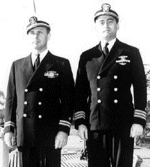 | 25k | Commissioning photo of Lt. Joslin (XO) and Cdr. Latta (CO) on board the Lagarto (SS-371) in Manitowoc on 14 October 1944. | Photo by Harry Berns, Official photographer of the Manitowoc Shipbuilding Co., Manitowoc, WI. Courtesy of Karen Duvalle Wisconsin Maritime Museum & dbfnetwork.info. |
|
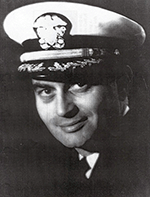 | 300k | Cdr. Latta (CO). | Courtesy of military-heroes.com. & submitted by Bill Gonyo. | |
 | 36k | Commissioning ceremony aboard the Lagarto (SS-371), in Manitowoc, Wisconsin on 14 October 1944. Cdr. Latta is third from the right. Charles West, the owner of the Manitowoc Shipbuilding Company, is first on the right, wearing civilian clothes. | Courtesy of Karen Duvalle Wisconsin Maritime Museum & dbfnetwork.info. | |
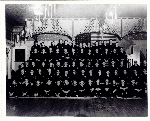 | 443k | Plank owners of the Lagarto (SS-371) pose for this commissioning party photo, probably 14 October 1944. Row 1 J.E. Davis, A. Brock, H.E. Ortega, C.W. Breithuapt, W.F. Moss, J.M. Marriot, J.L. Williams, W.H. Jordan, C.H. Bjornson, R.C. Perry, W.C. Shackelford, D.J. Taylor, R.F. Peterson, C.R. Byrer Row 2 R.B. Spalding, P. Cole, J.U. Marsh, L.G. Irving, W.R. Shaw, J.L. Cloman, H.G. Joslin, F.D. Latta, W.H. Mendenhall, H.A. Todd, A.G. Brewington, D.L. Skelly, C. Anker, F.D. Turner, H.D. Andrews Row 3 G.E. Halstead, C.W. McConnell, T.A. Fitzgerald, J.M. McGee, G.E. Clouse, P.A. O'Brien, R.L. Fisher, M.M. Wicklander, J.H. Root, A.J. Korogi, G.W. Keesee, C.D. Hart, D.J. Gray, A.M. Wade, O.R. Frasch, T.T. Finch, W. Graves Row 4 J.P. Gregory, R.F. Grace, F. Tait, J.C. Harrison, W.F. Honaker, J.H. Tapp, J.J. Franze, L.J. Lynch, U.M. St. John, J.B. Harris, L.F. Cathey, S.D. Remington Row 5 D.M. Paper, W.L. Moore, W.E. Hinken, A.H. Enns, J.W. Peterson, H.R. Plushnik, R.E. Simmerman, W.L. Britain, T. J. Harrington, F.A. Price, L.M. Doud, N.B. Lee, J.H. Thompson, W.N. Reno, I.L. Archibald. *Italic denote not on second patrol. | Photo by Harry Berns, Official photographer of the Manitowoc Shipbuilding Co., Manitowoc, WI. Photo submitted by Charles R. Hinman,Director of Education & Outreach, USS Bowfin Submarine Museum & Park, & On Eternal Patrol Partial text and i.d. courtesy of Nancy Kenney. Photo i.d. supplied by Karen Duvalle, Education Assistant/Special Events Coordinator,Wisconsin Maritime Museum. |
|
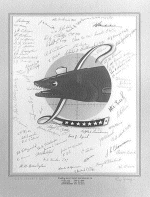 | 46k | Lagarto (SS-371) emblem and crew signatures, 14 October 1944. | Photo by Harry Berns, Official photographer of the Manitowoc Shipbuilding Co., Manitowoc, WI. Submitted by Larry Bohn, courtesy of the Wisconsin Maritime Museum, home of the Cobia (SS-245) | |
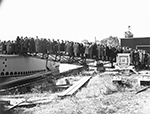 | 162k | Men and women, most in civilian dress, are lined up on a gang plank to board the submarine Lagarto (SS-371), docked in the Manitowoc River at the Manitowoc Shipbuilding Company shipyards, after the submarine's commissioning ceremony on 14 October 1944. | Photo courtesy of Wisconsin Maritime Museum | |
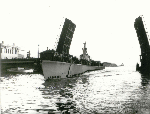 | 269k | With her crew lining her deck and lookouts in the periscope shears, the Lagarto (SS-371) passes between the two sections of an open draw bridge as the crowd from a Sears Roebuck and Co. building in Manitowoc watch the boat head off to the war, circa October - December 1944. The Lagarto is traveling up the Manitowoc river passing through the 8th St. bridge after some sort of trial run. I don't see a broom flying above the conning tower so it either wasn't entirely successful or wasn't the final trial before comissioning. By the way, the present day museum is in the exact location of the building just above the stern. That was the former Goodrich transport company's Manitowoc terminal and main Corporate office. | Photo by Harry Berns, Official photographer of the Manitowoc Shipbuilding Co., Manitowoc, WI. Photo submitted by Charles R. Hinman, Director of Education & Outreach, USS Bowfin Submarine Museum & Park, & On Eternal Patrol. Photo i.d. and partial text courtesy of Larry Bohn. |
|
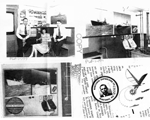 | 485k | Photo of Harry Berns, Official photographer of the Manitowoc Shipbuilding Co., Manitowoc, WI. The photo of the Golet (SS-361) encased in snow appears on the wall above him on the upper right. His obituary appears here. | Photo courtesy of Susan Menk, Archives Assistant, Wisconsin Maritime Museum, Dee Anna Grimsrud,Reference Archivist, Wisconsin Historical Society, Steve Khail, CBC, Director of Investor Relations & Corporate Communications, The Manitowoc Company, Inc. & William Young. | |
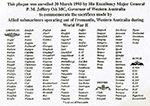 |
365k | This plaque was unveiled 20 March 1995 by His Excellency Major General P.M. Jeffery OA MC, Governor of Western Australia to commemorate the sacrifices made by Allied submarines that operated out of Fremantle, Western Australia during WW II. | Photo courtesy of Ron Reeves (of blessed memory). | |
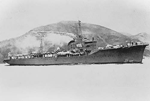 | 42k | Pictured here is the Japanese netlayer Hatsutaka which sank the Lagarto (SS-371). She is seen here leaving Aioi, 31 October 1939. | Photo from "Japanese Warships of World War II", Japanese Warships of World War II" by A. J. Watts, courtesy of Aryeh Wetherhorn (USNR). | |
 | 12k | Drawing of the Japanese netlayer Hatsutaka which sank the Lagarto (SS-371). | Photo from "Warships of the Imperial Japanese Navy, 1869-1945" by Hansgeorg Jentschura, courtesy of Aryeh Wetherhorn (USNR). | |
 | 5k | Map of the area where the the Lagarto (SS-371) sank the Japanese merchant cargo ship Tatsumomo Maru (880 BRT) off the the Bungo Suido, Kyushu, Japan in position 32.40N, 132.33E. | Photo & text courtesy of Great Circle Mapper - © Karl L Swartz / uboat.net. | |
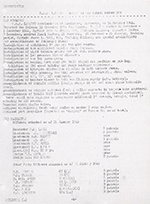 | 2.25k | 31 page PDF of Lagarto's (SS-371) WW II patrol. | Photo courtesy of Scott Koen & ussnewyork.com. | |
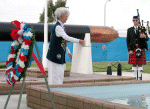 |
117k | Joyce DaSilva, the wife of Jesse DaSilva of the Tang (SS-306), one of the nine survivors of the boat, tosses a flower into a reflecting pool to honor the memory of one of the 52 submarines lost during World War II at the National Submarine Memorial-West on board Naval Weapons Station Seal Beach, Calif. On this Veterans Day, the Submarine Veterans of World War II transferred ownership of the memorial to the U.S. Navy. The following text is from The Coming Fury by Bruce Catton., pg. 478. "Major Sullivan Ballou of Rhode Island was killed in the battle, and just before it he had wrote to his wife, Sarah, to tell her that he believed he was going to be killed and to express a tremulous faith that could see a gleam of light in the dark: "But O Sarah! If the dead can come back to this earth and float unseen around those they loved, I shall always be near you in the gladdest days and in the gloomiest nights, always, always, and if there be a soft breeze upon your chest it shall be my breath, as the cool air fans your throbbing temple it shall be my spirit passing by. Sarah, do not mourn me dead; think I am gone and wait, for we shall meet again!" |
Text i.d. courtesy of Marlynn Starring. Photo i.d. courtesy of Chuck Senior, Vice Commander, Los Angeles-Pasadena Base, USSVI. USN photo # N-1159B-021 by Journalist 2nd Class Brian Brannon, courtesy of news.navy.mil. |
|
| Verification - 2006 | ||||
 | 262k | Senior Chief Master Navy Diver Michael Moser, of Camas, Wash., and British Diver Jamie MacLeod go over a chart of the World War II submarine Lagarto (SS-371) as 7th Fleet Diving Officer Cmdr. Tony San Jose watches aboard the rescue and salvage ship Salvor (ARS-52) in the Gulf of Thailand, 11 June 2006. Salvor divers are assisting the Naval Historical Center in attempting to positively identify the wreck. | USN photo & text of N-3483C-002 by Mass Communications Specialist 2nd Class Robert Shawn Cole, courtesy of news.navy.mil. | |
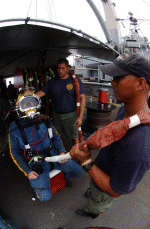 | 234k | Chief Navy Diver Russell Ciardiello stands by to be called to the stage aboard the rescue and salvage ship Salvor (ARS-52) with the help of Machinist's Mate 2nd Class Rick Parizal and Quartermaster 2nd Class Jason Tangalin. He will be diving on the World War II-era submarine Lagarto (SS-371). Salvor divers are assisting the Naval Historical Center in attempting to positively identify the wreck. The diving operation is part of the Thailand phase of the Cooperation Afloat Readiness and Training (CARAT) 2006 Exercise series. CARAT is an annual series of bilateral maritime training exercises between the U.S. and six Southeast Asia nations designed to build relationships and enhance the operational readiness of the participating forces. | USN photo & text of N-3483C-002 by Mass Communications Specialist 2nd Class Robert S. Cole, courtesy of news.navy.mil. | |
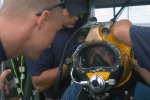 | 212k | Chief Navy Diver Jon Sommers performs diving supervisor checks on Gunner's Mate 2nd Bryan Zenoni, who is preparing to dive from Salvor (ARS-52) on 12 June 2006 on the World War II-era Lagarto (SS-371). | USN photo & text of N-0839W-009 by Lt. Erik Wells, courtesy of news.navy.mil. | |
 | 59k | Ensign Shauna Egan, of Burlington, Vt., tends her diver aboard Salvor (ARS-52) as he prepares to dive and investigate the World War II-era Lagarto (SS-371). | USN photo & text of N-3483C-007 by Mass Communications Specialist 2nd Class Robert Shawn Cole, courtesy of news.navy.mil. | |
 | 321k | Chief Navy Diver Jon Sommers and Navy Diver 1st Class Kevin Parsons monitor the surface phase of the decompression chamber aboard the rescue and salvage ship Salvor (ARS-52) in the Gulf of Thailand, 12 June 2006.Salvor is moored over the World War II-era submarine Lagarto (SS-371). | USN photo & text of N-3483C-003 by Mass Communications Specialist 2nd Class Robert S. Cole, courtesy of news.navy.mil. | |
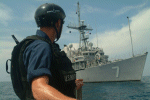 | 158k | Mineman 2nd Class Simon S. Walters, assigned to the mine warfare ship Patriot (MCM-7), prepares to throw a line to his ship during mine-recovery operations as part of Western Pacific Mine Countermeasures Exercise (WP-MCMEX) in Malaysia, 14 June 2006. The 3rd annual WP-MCMEX focuses on enhancing cooperation among Western Pacific Naval Symposium (WPNS) navies and maritime safety by conduction detection, identification procedures that may be used in the future to keep important international waterways open. | USN photo & text of N-4124C-020 by Mass Communications Specialist 2nd Class Robert S. Cole, courtesy of news.navy.mil. | |
 | 593k | Chief Navy Diver Jon Sommers assigned to the salvage ship Salvor (ARS-52) searches for an identifying marker on the forward capstan of the submarine Lagarto (SS-371) on 14 June 2006. | USN photo & text of N-0000S-001 by Chief Diver Jon Sommers, courtesy of news.navy.mil. | |
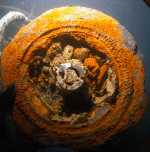 | 439k | Chief Navy Diver Jon Sommers assigned to the salvage ship Salvor (ARS-52) searches for an identifying marker on the forward capstan of the submarine Lagarto (SS-371) | USN photo & text of N-0000S-002 by Chief Diver Jon Sommers, courtesy of news.navy.mil. | |
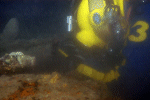 | 516k | U.S. Navy diver assigned to the salvage ship Salvor (ARS-52) cleans marine growth from a hatch of the submarine Lagarto (SS-371). | USN photo & text of N-0000S-003 by Chief Diver Jon Sommers, courtesy of news.navy.mil. | |
 | 324k | A wreath that will be placed in the ocean above the resting site of the World War II submarine Lagarto (SS-371) is displayed during a memorial at sea aboard the salvage ship Salvor (ARS-52) in the Gulf of Thailand on 17 June 2006. The ceremony was in remembrance of Lagarto's lost crew of 86 Sailors. | USN photo & text of N-3483C-002 by Mass Communications Specialist 2nd Class Robert S. Cole, courtesy of news.navy.mil. | |
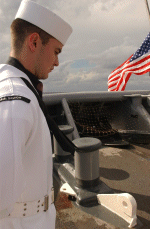 | 197k | Interior Communications Electrician 1st Class (SW) Anthony Marquez, of Prineville, Oregon, bows his head in prayer during a memorial at sea aboard Salvor (ARS-52) in the Gulf of Thailand 17 June 2006 remembering the 86 Sailors who were lost aboard submarine Lagarto (SS-371) during World War II. | USN photo & text of N-3483C-001 by Mass Communications Specialist 2nd Class Robert S. Cole, courtesy of news.navy.mil. | |
 | 255k | Sailors stationed aboard the salvage ship Salvor (ARS-52) stand at parade rest during a memorial at sea honoring the 86 Sailors, who were lost in the submarine Lagarto (SS-371) during World War II. | USN photo & text of N-3483C-004 by Mass Communications Specialist 2nd Class Robert S. Cole, courtesy of news.navy.mil. | |
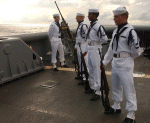 | 166k | Sailors of a firing squad aboard Salvor (ARS-52) stand at parade rest during a memorial at sea, honoring the 86 Sailors who were lost in the submarine Lagarto (SS-371) during World War II. | USN photo & text of N-3483C-005 by Mass Communications Specialist 2nd Class Robert S. Cole, courtesy of news.navy.mil. | |
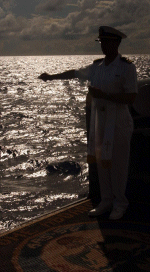 | 183k | During a memorial at sea aboard Salvor (ARS-52), Lt. (Chaplain) Alfred Pena, of Los Angeles, Calif., releases to the sea the names of Sailors lost aboard submarine Lagarto (SS-371) during World War II. | USN photo & text of N-3483C-003 by Mass Communications Specialist 2nd Class Robert S. Cole, courtesy of news.navy.mil. | |
 | 335k | U.S. Navy diver Hospital Corpsman 2nd Class Brad O'Keefe shows Royal Lt.j.g. Mongkol Podang a drawing of Lagarto (SS-371) during a visit to rescue and salvage ship Salvor (ARS-52) at Sattahip, Thailand, 21 June 2006. | USN photo & text of N-9851B-001 by Mass Communications Specialist 2nd Class John L. Beeman, courtesy of news.navy.mil. | |
 | 147k | The U.S. flag reflects off a plaque from the crew of the rescue and salvage ship Salvor (ARS-52) to the crew of Lagarto (SS-371). On 16 June the plaque was placed on the aft capstan of the wreckage in the Gulf of Thailand of the lost World War II submarine. | USN photo & text of N-3483C-001 by Mass Communications Specialist 2nd Class Robert Shawn Cole, courtesy of news.navy.mil. | |
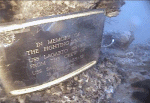 | 49k | A plaque placed on the aft capstan of the wreckage in the Gulf of Thailand believed to be that of World War II submarine Lagarto (SS-371) is seen in this screen grab of video on 16 June 2006. The divers' observations appear to confirm the discovery made in May 2005 by British wreck diver Jamie MacLeod. "Without a doubt, it's a U.S. submarine, a Balao-class," said U.S. 7th Fleet Diving Officer, Cmdr. Tony San Jose. San Jose and his fellow divers reported identifying twin 5-inch gun mounts both forward and aft, a feature believed to be unique to Lagarto. They also reported finding serial numbers and the word "Manitowoc" engraved on the submarine's propeller. Lagarto was one of 28 submarines built in Manitowoc, Wisc. The operations were conducted from the rescue and salvage ship Salvor (ARS-52) with embarked divers from Mobile Diving and Salvage Unit (MDSU) 1, based in Pearl Harbor, Hawaii. The Japan-based mine countermeasures ship Patriot (MCM-7) assisted by first pinpointing the location of the wreckage with its SQQ-32 sonar and remotely-operated Mine Neutralization Vehicle. In Memorium: In the Second Book of Shmuel (Samuel), 22nd chapter, 5th through the 20th verses, translated from the original in Hebrew and published by the Koren Publishers of Jerusalem, Israel, 1982, can perhaps aptly describe the fate of the crew and all other U.S. submariners who died defending their county: "When the waves of death compassed me / the floods of ungodly men made me afraid; / the bonds of She'ol encircled me; / the snares of death took me by surprise; / in my distress I called upon the Lord, / and cried to my G-D: / and he heard my voice out of his temple, / and my cry entered into his ears. / Then the earth shook and trembled; /the foundations of heaven moved / and shook because of his anger /...the heavy mass of waters, and thick clouds of the skies /... And the channels of the sea appeared, / the foundations of the world were laid bare, / at the rebuking of the Lord, at the blast at the breath of his nostrils. / He sent from above, he took me; / he drew me out of many waters; / he delivered me from my strong enemy, and from those who hated me; for they were too strong for me. / They surprised me in the day of my calamity: / but the Lord was my stay / He brought me forth also into a large place: / he delivered me because he delighted in me./" |
USN photo & text of N-0000M-001 by Senior Chief Navy Diver Michael Moser, courtesy of news.navy.mil. | |
| Discovery - 2005 | ||||
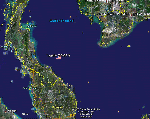 | 77k | The Lagarto (SS-371) was found just a few days ago (late April 2005) by local wreck divers Jamie Macleod & Stewart Oehl of MV Trident near it's reported last siting.
The Lagarto was found by comparing it's last known position against
hundreds of fisherman's 'net snag' marks in the area of interest.
5 fisherman's marks in particular, were close to the sinking site. Normally it might take days or weeks of Sidescan sonar runs to locate a new wreck in this depth of water, but in an extraordinary stroke of good luck, the Lagarto appeared at the closest of these fisherman's marks. For 60 years the Lagarto rested untouched on the seabed in 70 meters of water about 150 kilometers off the southeast coast of Thailand. The top of the conning tower is at 55 meters. Local dive operators on the tiny resort island of Koh Tao knew of the submarine's fate, but couldn't pinpoint her location until recently. "We've always known that since the end of the war there's been a submarine missing around there," said British wreck diver Jamie MacLeod, who discovered the 110-meter submarine. "We went into all the war-time records, cross-referenced them with fisherman's marks and then searched with sonar and it came up trumps - we found a bump on the bottom, went down the line and there it was." MacLeod said, "It looks to me like it's intact and it's sitting upright on the bottom in very clear water, so you can get a good idea of what it looks like. Everything is still on it - all the armaments, the brass navigation lights. It's beautiful." It is planned to revisit the Lagarto in July, this time to further document the vessel. Jamie has informed Roy Leonhardt that he is honored to lay a wreath or place a memorial plaque on the Lagarto on behalf of United States Submarine Veterans of World War II. Jamie's first view of the Lagarto was of the bow area which appeared exactly as in the black and white image that remains as one of the few pieces of evidence documenting the Lagarto when still afloat. To the left is a Google Earth satellite photo of the general area in which site and surrounding islands of Lagarto's final resting place and her crew. | Courtesy of Steve Burton "B2"
Diver/Engineer,
Director, Technical Diving,
Mermaids Dive Center
Scuba Technician Resource Web Site Thailand Shipwreck Information Web Site Submitted by Jack Treutle (of blessed memory). Partial text courtesy of Asia Times Online. View courtesy of Google Earth. |
|
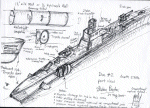 | 272k | Drawing of the Lagarto (SS-371) made on the second dive on her, dated 29 July 2005, at a depth of 230 feet. This drawing shows massive damage to her portside bow area, with outer plating destroyed and a hole blown inward into the forward battery room, wardroom area, & normal fuel oil tank No. 1, probably from the result of depth charging. Simply speculating, but due to reports that the Lagarto was sunk at night (00:10), she may have been making a night surface attack when the radar equipped Japanese netlayer Hatsutaka detected her and possibly put two shell holes through her conning tower (see drawing) and then delivered her lethal depth charge attack which sunk the Lagarto. | Drawing courtesy of Steve Burton "B2" Diver/Engineer, Director, Technical Diving, Mermaids Dive Center Scuba Technician Resource Web Site Thailand Shipwreck Information Web Site |
|
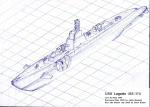 | 272k | Drawing of the Lagarto (SS-371) made on the second dive on her, dated 29 July 2005, at a depth of 230 feet. | Drawing courtesy of Steve Burton "B2" Diver/Engineer, Director, Technical Diving, Mermaids Dive Center Scuba Technician Resource Web Site Thailand Shipwreck Information Web Site |
|
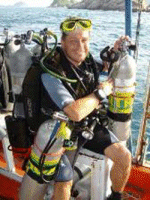 | 405k | The following article appears in its entirety from the August 8th chicagotribune.com, link courtesy of usslagarto.com.
In the ghostly blue lights of a video camera, sea snakes, squids and schools of blue and yellow fish swirl past five-inch battle guns of a World War II submarine 200 feet beneath the South China Sea. "With all the fish and the coral covering the Lagarto, it's almost like someone put flowers on a grave," said Elizabeth Kenney-Augustine, whose grandfather, Bill Mabin of La Grange, was on the vessel. For decades, no human knew where to put flowers for the 86 men who disappeared with the Lagarto somewhere between Thailand and Australia shortly before World War II ended. In May, a diving team, following the hints of fishermen telling tales of snagged nets, discovered the Lagarto in the Gulf of Thailand. Experts say this is the missing boat because it is believed to be the only American Balao class submarine sunk in the Gulf of Thailand during the war, and because Japanese records released after the war show Japanese sailors sank a submarine in the area where the Lagarto disappeared. "We believe the wreck to be the Lagarto," said Jamie Macleod, who, with the U.S. Navy's permission, dove down to look at the outside of the vessel. Macleod and Stewart Oehl of the MV Trident dive boat in Thailand discovered the missing submarine. Author Clive Cussler has spoken with the men about a documentary on the Lagarto, as well as their discovery. U.S. Rep. Daniel Lipinski (D-Ill.) has called on the U.S. Navy to confirm the submarine's identity. After talking with the family, Macleod took Kenney-Augustine and her brother, John Kenney Jr., off the shores of Thailand last week to read letters and poems from family members in the first burial ceremony the missing men have had. On July 31, a diver tucked a dozen white roses into the conning tower, or attack center, of the Lagarto. Minutes later, the flowers had disappeared. "We thought that was nice," said Kenney-Augustine, of Chicago's Wicker Park neighborhood. "Like they accepted our offering." For 60 years, Mabin's daughter, Nancy Kenney of Lake Leelanau, Mich., wondered if her father had somehow come out of the war alive. She waited for him to be released from a prisoner-of-war camp. Or to appear on a remote island. Or to pop through the front door after a top-secret mission. She knows the families of the other 85 men on board the submarine must have wondered the same things. "From the letters between my mother and the other wives, I can see there was great confusion," Kenney said. "They were hoping their husbands were in prison camp. Imagine that--seeing that as the best-case scenario." Kenney was 2 when her father was lost. She said her mother, Margaret Chambers of Glen Arbor, Mich., was pleased to hear her husband's resting place had been found. "He was the love of her life," Kenney said. "She's been shaken by this." The Lagarto was one of 28 submarines built in Manitowoc, Wis., and the Wisconsin Maritime Museum has adopted the submarine and created a memorial to it. According to the museum, the submarine was tested in Lake Michigan. It left Subic Bay in the Philippines on April 12, 1945, for the Siam Gulf, now the Gulf of Thailand, for its second trip. Baya (SS-318) officers reported at the time that they were to rendezvous with the Lagarto to discuss plans to attack a Japanese convoy on May 3, 1945. At 1 a.m. May 4, 1945, the Japanese convoy drove off the Baya, but nothing was ever heard again from the Lagarto. It was supposed to dock in Australia at the end of May, but it never arrived. In June 1945, Mabin's family received a letter saying he was missing in action. A year later, another letter arrived describing him as "presumed dead." "This will give you a real glimpse into World War II," Kenney said. "This is what I grew up with. That's the last correspondence any of the families had with the Navy." After the war ended, the Japanese released records showing the minelayer Hatsutaka sunk a submarine at the same time and same place the Lagarto was believed to be during the war, but there was no confirmation. Kenney's children grew up with Mabin's ghost. Every year on Memorial Day, John Kenney has searched the Internet for some sign of his grandfather. "This year, I did a Google search, and someone had posted that it had been found," John Kenney said. "Two divers had found it. It's considered one of the holy grails of Asian diving because it's one of the only U.S. subs lost anywhere near the Gulf of Thailand." Kenney said he immediately called her mother and asked if she were sitting down. After he told her, she began to cry. "I went through so many emotions," Nancy Kenney said. "It's an odd feeling to grieve for someone 60 years after they're gone." She began to contact the families of the missing men. Kelan Spalding's brother R.B. Spalding of Springfield, Mo., was also on the Lagarto. "My wife heard about it on the news and said, `Do you suppose that could be Bobby's sub?'" Spalding said. "But I thought it would be in deeper water." Then he got the call from Nancy Kenney. "I was 9 years old when it went down," he said. "I'm relieved to know exactly why and how and where. I hope they allow the divers to film it." But he doesn't want anyone to go inside the sub. And no one will. According to the U.S. Navy, all sunken U.S. ships are considered grave sites and are off-limits. But Macleod said the divers don't want to go inside the submarine. "We have no plans to explore the wreck," Macleod said. "We hope to be able to conduct non-intrusive filming only." For the families, seeing the outside of the submarine has provided closure. "I thought there would be a moment when they scraped the coral off and found letters: Lagarto," Kenney-Augustine said. "But it wasn't like that. We just sat above as they dove beneath, and I thought, `How wonderful.' It was similar to going to a cemetery and visiting a loved one who has passed and standing over his grave." John Kenney said the submarine is sitting upright as if it sank straight down. There are no numbers or names on the side, and research shows the only place divers could find the name of the ship is inside the captain's quarters. Instead, they used the five-inch guns--an upgrade from previous subs and a good marker for the Balao class and the slant of the bow to determine its make. The teak deck and outer superstructure have deteriorated and been torn away, leaving the pressure hull, the conning tower, and a perfectly preserved light. On the port side, the middle torpedo bow tube remains open. The torpedo is missing. "It looks like they went down fighting," John Kenney said. "I can't tell you how wonderful the divers have been--so sensitive to the families," Nancy Kenney said. "They even attached an American flag at the top of the tower. I thought, `God bless them for that.'" | Photo courtesy of Steve Burton "B2" Diver/Engineer, Director, Technical Diving, Mermaids Dive Center Scuba Technician Resource Web Site Thailand Shipwreck Information Web Site |
|
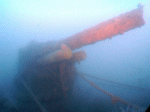 | 221k | One of the two deck guns (a key identification feature of the Lagarto (SS-371). Fishing net debris is clearly visible in this case. Much of the Lagarto was shrouded in fishing net and line, in low visibility water, and with an oceanic current sweeping the vessel from bow to stern, making the research dives a particularly hazardous activity for all involved.
4 dives were necessary just to swim around the Lagarto. Each dive team member wore more than 200 pounds of equipment. Visibility on the Lagarto during the first dive was such that I used a line and reel to swim out and back from the conning tower to the bows. On the 4th dive as I got to know the wreck layout better, I still missed the conning tower swimming back from the props on one occasion. Above the thermocline, the visibility improved dramatically to more than 200ft. Divers could see the sunlight twinkling on the surface as soon as they started their lengthy decompression stops. One team diver used a former US-Navy MK15 re-breather for the Lagarto dives. This 'NATO-Stock number' item is currently listed as costing US$17,500, has his particular variant has a depth rating of 450m/ 1,500ft. A picture from directly above the wreck unfortunately only shows the very tip of the conning tower reaching up out of the silty thermo-cline. The visibility over the wreck of the Lagarto varies according to what time of the year she's dived. On the first visit, visibility on the bottom was approx 50ft. Sadly on the last visit, visibility above the wreck was a fantastic 200ft, but below the tip of the conning tower, visibility was only maybe 15ft. These conditions are typical in the South China Sea region. | Photo & text courtesy of Steve Burton "B2" Diver/Engineer, Director, Technical Diving, Mermaids Dive Center Scuba Technician Resource Web Site Thailand Shipwreck Information Web Site |
|
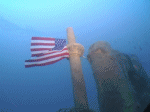 | 136k | The top of the conning tower appearing out of the thermocline at approx 200ft. The number 1 & 2 periscopes shears and the remains of the SJ radar post are clearly visible. The 'stars & stripes' was sent by one of the families of the crew lost during the sinking, and was attached during a memorial service held at the Lagarto (SS-371) site conducted by John and Beth (Grandchildren of Mabin, W. T. SM1). | Photo & text courtesy of Steve Burton "B2" Diver/Engineer, Director, Technical Diving, Mermaids Dive Center Scuba Technician Resource Web Site Thailand Shipwreck Information Web Site |
|
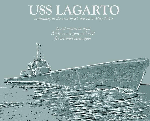 | 62k | Commemorative photo in honor of the memory of the crew of the Lagarto (SS-371). | Photo courtesy of Tom Kermen. Dante's Prayer courtesy of Loreena McKennitt via loreenamckennitt.com | |
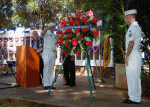 | 440k | U.S. Navy submarine veterans are honored in a Veterans Day ceremony held on board Naval Station Pearl Harbor at the Parche Memorial, November 11, 2005. Among those honored included the 86 lost aboard the recently discovered missing World War II submarine Lagarto (SS-371). It was discovered in May 2005 off the coast of Thailand where it was sunk on May 4, 1945. A Memorial Service sponsored by American Legion Post 639 was held on September 17 in Springfield Missouri. For reasons known to only our Creator, this would mark the first of 4 occurrences where a lost WW II U.S. submarine would have such an event befall to them during the Hebrew calendar week coinciding with the week's Bible portion that was read in synagogues around the world in Deuteronomy, 21:10 to 25:19. In Hebrew it is called Ke-Tatze La Malchama: (When you go off to war....) 74 of the 613 commandments are in this reading. The one commandment in particular which is a shared event (which I see) in this sequence over a 3 year period (2006-8) is the commandment of HaShevat Avedah, translation: returning a lost object. In Chapter 22, verse 3: "You shall return every lost thing of your brother's...". One of the leading sages of Israel, Rabbi Zev Leff of Moshav Mattityahu mentioned that this includes helping to return a lost body as well. There is obviously more built into it than that, but it will do for starters. The commandments have been learned out in depth over centuries (3,000 + years) by the brightest minds of Israel. The Oral Torah, known as the Gemora, (Babylonian or Jerusalem version) is an extrapolation of the written Torah which was never translated when the Written Bible was codified into Greek. The tractate Sanhedrin deals with this subject in detail. On 24 August 2007, the Grunion (SS-216) was found on the same Bible reading. It was found near the island of Segula, which in Hebrew means special treasure, or jewel. It is a common word in Hebrew and it is found 8 times in the Bible #1. Exodus 19:5, #2. Deuteronomy 7:6, #3. 14:2 & #4. 26:18. #5. Malachi 3:17. #6. Psalms 135:4 #7. Ecclesiastes 2:8 #8. Chronicles I 29:3 The company that found the Grunion,Williamson Associates, was acting as a subsidiary of Nauticos; also helped find Israel's lost submarine, the Dakar, which amazingly was neither lost or found in the Bible reading of Ke-Tatze. It was found on the reading of Nasso, which is in Numbers 4:21 - 7:89. On 12 September 2008 I received a response from Charles R. Hinman, director of oneternalpatrol.com, regarding a BTW from a photo i.d. of the Capelin (SS-289) which I had sent to him in April and again 3 weeks earlier in August. He informed me that the last state in the U.S. to set aside its memorial for the 52 lost WW II boats, Oregon, was finally dedicating their submarine memorial to their assigned boat, the Albacore (SS-218). Since WW II, this boat's resting place which is believed to be in position 41.49N, 141.11E. and for the last 64 years thought to be in northeastern Hokkaido is actually off the eastern coast of southern Hokkaido's Kameda Peninsula. This info also arrived on the same reading for the week. Same reading on the same subject matter over a 5 year period. Note: The Hebrew Calendar is a lunar based 354 day year with a 19 year cycle which includes 7 leap years built into it; one about every 2-3 years. | USN photo & text of # N-0879R-001 by Chief Journalist David Rush, courtesy of news.navy.mil. | |
| Dive Photos by Steve Hubbard | ||||
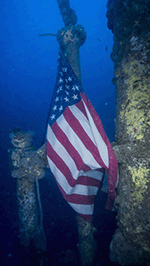 | 485k | Old Glory still flies from the Lagarto, 2013. | Photo courtesy of Steve Hubbard. | |
 | 821k | Serious marine growth after 68 years. | Photo courtesy of Steve Hubbard. | |
 | 168k | Looking down into the bridge starboard side. | Photo courtesy of Steve Hubbard. | |
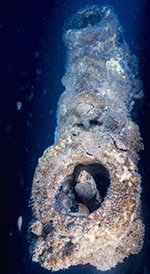 | 531k | Top of the periscope wells with periscope inside. | Photo courtesy of Steve Hubbard. | |
 | 531k | 5"/25 deck gun. | Photo courtesy of Steve Hubbard. | |
 | 1.43k | Forward starboard torpedo door open. | Photo courtesy of Steve Hubbard. | |
 | 1.59k | 5"/25 deck gun. | Photo courtesy of Steve Hubbard. | |
View the Lagarto (SS-371)
DANFS history entry located on the Haze Gray & Underway Web Site.
Crew Contact And Reunion Information
U.S. Navy Memorial Foundation
Fleet Reserve Association
Additional Resources and Web Sites of Interest
On Eternal Patrol
ComSubPac Report on the loss of LAGARTO (SS 371) May 3, 1945 - 86 Men Lost
Ep-21 (1) - Victory At Sea ~ Full Fathom Five - HQ
usslagarto.com
Lagarto Model
Youtube video from Wisconsin Maritime Museum
Manitowoc Built Submarines
| Back To The Main Photo Index | Back To the Submarine Index |
| Problems and site related matters, E-mail Webmaster |
| This page is created by Gary Priolo and maintained by Michael Mohl All Pages © 1996 - 2023, NavSource History All rights reserved. |